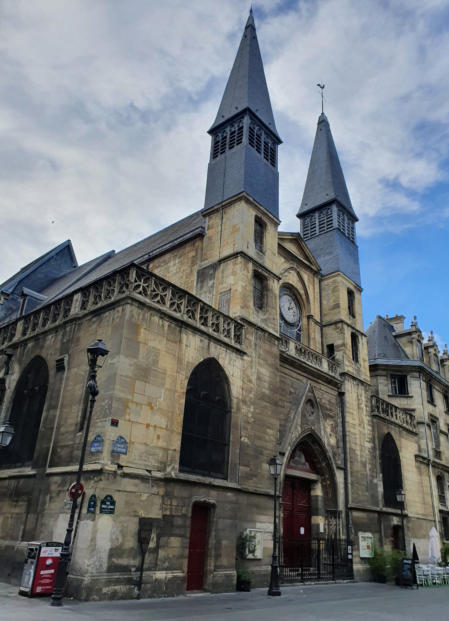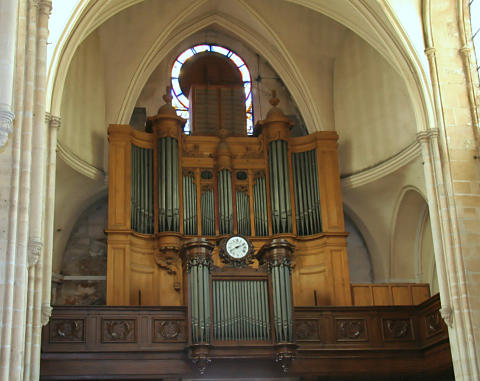


ORGANS OF PARIS © 2025 Vincent Hildebrandt HOME ALL ORGANS


Saint-Leu-Saint-Gilles, located in the heart of Paris,
dates back to the 13th Century (1230). It is one of the
few religious monuments left from that period, standing
along the old Roman road (Rue Saint Denis) leading to
Saint-Denis, Pontoise and Rouen, which later became
the triumphal road for royal entries into the capital.
When Saint-Gilles chapel became too small in the 14th
Century, the current Saint-Leu church was built (1310),
which explains the two saints in its name. It was
reconstructed several times in the following centuries.
Due to the break-through of the Boulevard Sébastopol,
the choir was shortened with 5 meters and three
chapels were demolished mid 19th century. Victor
Baltard restorated the church, adding lateral chapels.
Also, a tower and clock were added (1858).
The nave is built in gothic style, whereas the choir is
built in renaissance-style.
The church is the home of an ancient religious alliance,
les Chevaliers du Saint Sépulcre de Jérusalem.

A1
The organ of Saint-Leu-Saint-Gilles was built in 1788 by
François-Henri Clicquot. It reused part of the old organ built
by Guy Jolly in 1658-1659, which was an extension of an organ
built before 1603 and modified by builders Mathieu
Langhedul (1603) and Pierre Pescheur (1619). The central part
of the large case still remains of this instrument. It was Jolly
who added the Positive. At that time, the instrument spoke
on 3 manuals and pedalboard and 25 stops. In 1671, a new
reconstruction of the instrument took place by Enocq, who
added a fourth manual, enlarged the range of the pedalboard
and changed 10 stops, but did not profoundly modify the
sound characteristics. The instrument had 4 manuals and 28
stops.
1788
François-Henri Clicquot had a profound impact on the organ
of St-Leu-St-Gilles. He added the concave wings to the case of
the great organ. Apart from a part of the case that he took
over, it is very likely that he renewed all the piping and
mechanics.
1867
In 1867, Suret modified the organ:
•Added an expressive keyboard with 6 stops but speaking
only on part of the keyboard.
•Removed both the Récit and Echo keyboards accordingly.
•Changed the composition of some keyboards: for example,
Suret removed 3 to 4 stops from the positive to install two
eight-foot stops and move the oboe to the new expressive
Swell.
• Changed the keyboards on the console, to make it easier for
the organist to play.
Nevertheless, Suret retained most of Clicquots mechanics
(including windchests) and much of the sound material.
1911-1912
Mutin intervened in 1911-1912, probably to repair some
damage done by the Paris Commune (disappearance of
certain stops?) and to make some adaptations: removal of the
French-style pedalboard (apparently kept by Suret), revoicing
of the Plein Jeu, possible addition of harmonic reed stops, etc.
1920
In the early 1920s, the organ builder Béasse also made some
adaptations.
Throughout the twentieth century, the organ underwent no
intervention and its condition slowly deteriorated. Running
out of steam in 1967, the organ suffered major damage in a
fire in 1974. And what wasn't destroyed by fire and heat was
likely to be damaged by the water used to extinguish the fire.
Since then, the organ has been completely unplayable.
An association was founded in 2012 to raise funds for a
restoration, which is now scheduled for 2025-2027 (set aside
that still 650.000 euros have to be found to finance this
project).
The organ has 14 stops that predate the Revolution (11
complete, 3 partial), 9-10 Suret stops and 2 Mutin's stops.
Video of the organ in its present state.
Site of the organ
Brochure
All Parisian organs built before the revolution


In the plan to maintain the cultural heritage of the City of
Paris, this organ is among the four prestigious and
emblematic instruments, classified as Historic Monuments,
requiring a fundamental restoration.
Restoration issues
The first known interventions of organ builders in Saint-
Leu-Saint-Gilles date back to 1619: the organ builder
Pescheur then modified and enlarged the original organ
but retained its buffet: the instrument was still modest in
size with a keyboard and a pedal ‘en tirasse’. In the mid-
17th century, it is certain that the instrument was no
longer sufficient for the new musical repertoire of the
time and the needs of the liturgy. As early as 1637, the
organ builder Jolly carried the instrument almost to the
dimensions that we know it today by adding a Positive.
In 1659, the organ consisted of 27 stops. In 1671, Enocq
added a fourth keyboard, expanded the scope of the
pedal and changed ten stops, but did not fundamentally
alter the sound characteristics. François-Henri Clicquot's
intervention deeply marks the instrument since most of
the mechanics, more than 60% of the piping and an
important part of the buffet can be attributed to him.
Suret modified the Clicquot organ without distorting it in
1855, among others: the addition of an expressive
keyboard, the consequent removal of the Récit and Echo
keyboards, the modification of the composition of
certain keyboards and the change of the keyboards of
the console...
Mutin intervened in 1911-1912, probably to repair some
damage that occurred during the Paris Commune and
modernize the organ "to the taste of the day", among
others: removal of the French pedal, reharmonization of
the Plein Jeu, addition of harmonic reed stops.
Unfortunately, in 1974, a fire caused extensive damage.
Since then, it has been totally unplayable.
The current condition of the instrument requires a major
restoration: cleaning of the mechanics and piping,
reconstruction of the missing pipes, complete
restoration of the wind chests, repair of the console,
resumption of power and treatment of the buffet. The
preliminary study is to be carried out by a state
consultant technician.
Call to Patronage: 2,280,000 euros, exclusive the costs
associated with the project management are added to this
amount and will be borne by the City of Paris.
Source


1788 - Clicquot (3)
1855 - Suret (5)
1912 - Mutin (5)
1920 - Béasse (5)
III/24 - traction mécanique
composition
Silent since 1974

Organiste conservateur
François Périllon
Concerts
-
Masses with organ
-
Vidéos
-
All organs built before the revolution
The organs of Paris
ORGANS OF PARIS © 2025 Vincent Hildebrandt ALL ORGANS

1788 - Clicquot (3)
1855 - Suret (5)
1912 - Mutin (5)
1920 - Béasse (5)
III/24 - traction mécanique
composition
Silent since 1974
A1
The organ of Saint-Leu-Saint-Gilles was built in 1788 by
François-Henri Clicquot. It reused part of the old organ built
by Guy Jolly in 1658-1659, which was an extension of an organ
built before 1603 and modified by builders Mathieu
Langhedul (1603) and Pierre Pescheur (1619). The central part
of the large case still remains of this instrument. It was Jolly
who added the Positive. At that time, the instrument spoke
on 3 manuals and pedalboard and 25 stops. In 1671, a new
reconstruction of the instrument took place by Enocq, who
added a fourth manual, enlarged the range of the pedalboard
and changed 10 stops, but did not profoundly modify the
sound characteristics. The instrument had 4 manuals and 28
stops.
1788
François-Henri Clicquot had a profound impact on the organ
of St-Leu-St-Gilles. He added the concave wings to the case of
the great organ. Apart from a part of the case that he took
over, it is very likely that he renewed all the piping and
mechanics.
1867
In 1867, Suret modified the organ:
•Added an expressive keyboard with 6 stops but speaking
only on part of the keyboard.
•Removed both the Récit and Echo keyboards accordingly.
•Changed the composition of some keyboards: for example,
Suret removed 3 to 4 stops from the positive to install two
eight-foot stops and move the oboe to the new expressive
Swell.
• Changed the keyboards on the console, to make it easier for
the organist to play.
Nevertheless, Suret retained most of Clicquots mechanics
(including windchests) and much of the sound material.
1911-1912
Mutin intervened in 1911-1912, probably to repair some
damage done by the Paris Commune (disappearance of
certain stops?) and to make some adaptations: removal of the
French-style pedalboard (apparently kept by Suret), revoicing
of the Plein Jeu, possible addition of harmonic reed stops, etc.
1920
In the early 1920s, the organ builder Béasse also made some
adaptations.
Throughout the twentieth century, the organ underwent no
intervention and its condition slowly deteriorated. Running
out of steam in 1967, the organ suffered major damage in a
fire in 1974. And what wasn't destroyed by fire and heat was
likely to be damaged by the water used to extinguish the fire.
Since then, the organ has been completely unplayable.
An association was founded in 2012 to raise funds for a
restoration, which is now scheduled for 2025-2027 (set aside
that still 650.000 euros have to be found to finance this
project).
The organ has 14 stops that predate the Revolution (11
complete, 3 partial), 9-10 Suret stops and 2 Mutin's stops.
Video of the organ in its present state.
Site of the organ
Brochure
All Parisian organs built before the revolution























